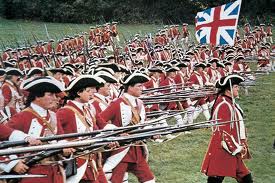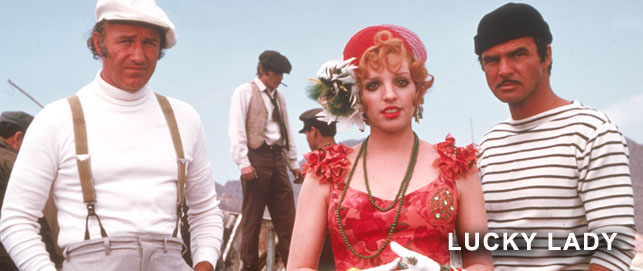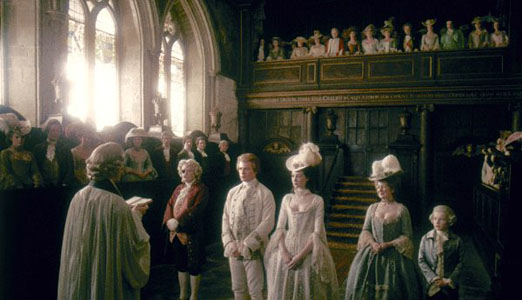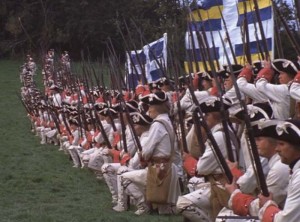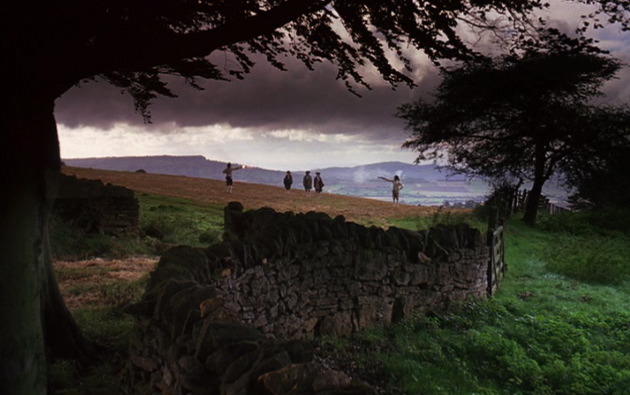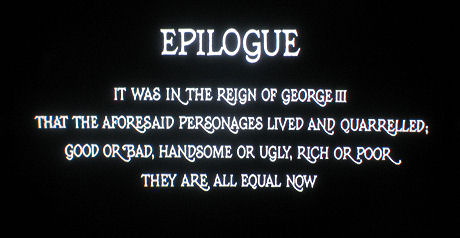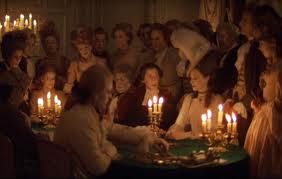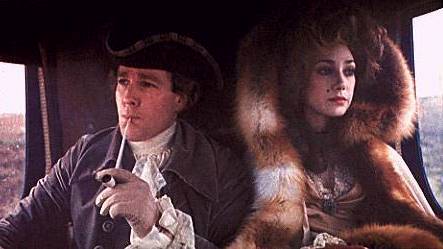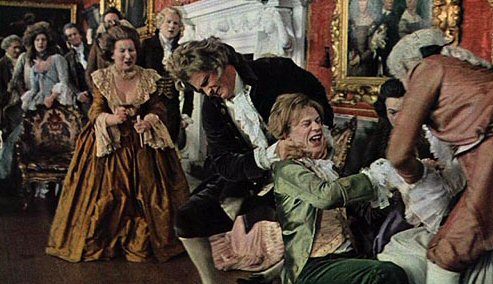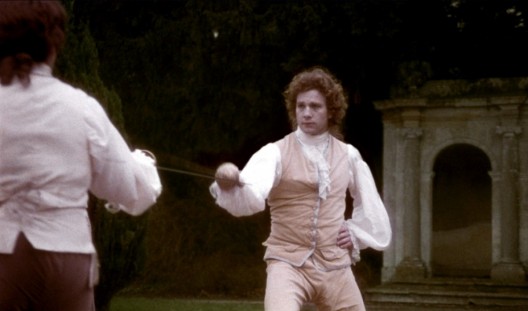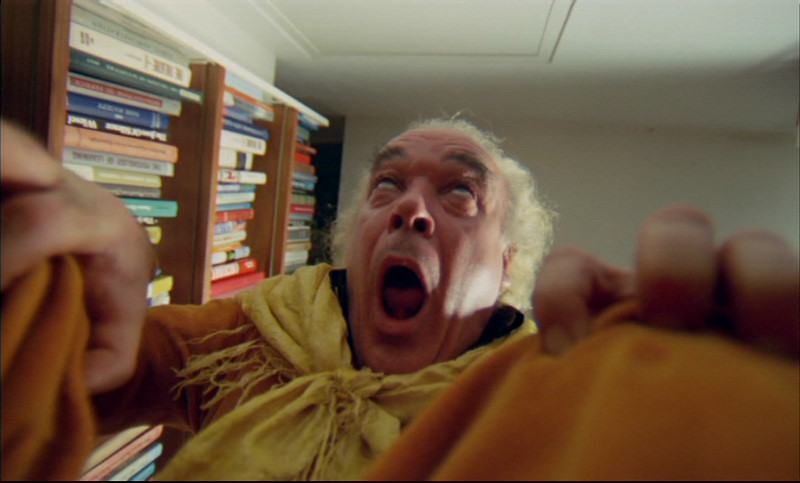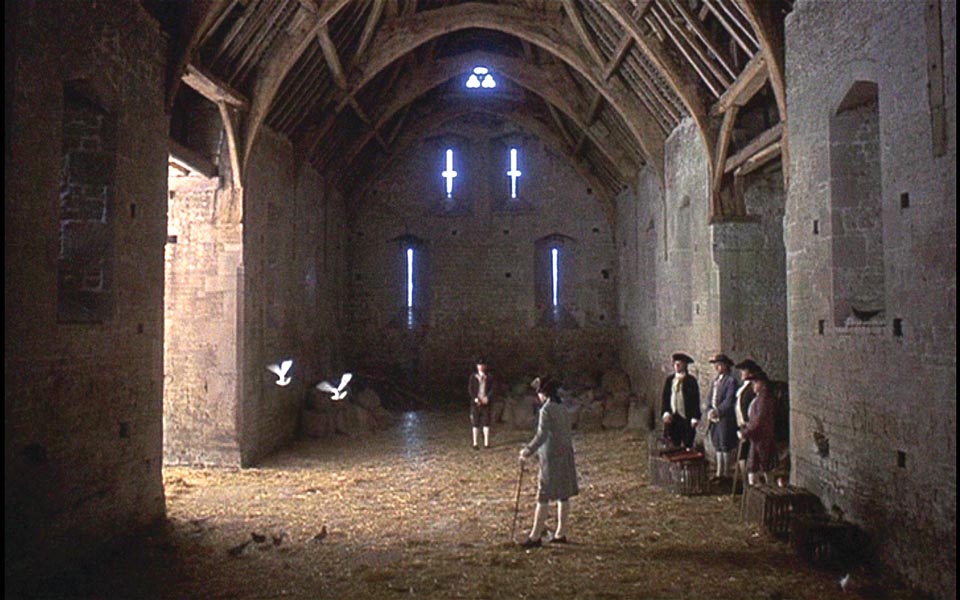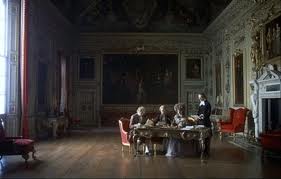From the March-April 1976 Film Comment. I’m somewhat irritated today by the hectoring tone of this, but I tend to think most of my arguments are sound — apart from my far-too-facile insistence that Barry Lyndon is a failure, which I would now dispute. — J.R.
So BARRY LYNDON is a failure. So what? How many “successes” have you seen lately that are half as interesting or accomplished, that are worth even ten minutes of thought after leaving them? By my own rough count, a smug little piece of engineering like a CLOCKWORK ORANGE was worth about five. I’m reminded of what Jonas Mekas wrote about ZAZIE several years ago: “The fact that the film is a failure means nothing. Didn’t God create a failure, too?”
Anyway, what most Anglo-American critics appear to mean by failure is that they were (a) bewildered and (b) bored by their bewilderment. To some extent, I was bewildered and befuddled too. So what? Who says we have to understand a film back to front before we can let ourselves like it? “The fault, dear Brutus, is not in our stars,/But in ourselves, that we are underlings.”
London critics got to see BARRY LYNDON at least a couple of weeks before their New York counterparts, so the contrasts and comparisons that were drawn were somewhat different: while most of the former chastised Kubrick for his beautiful images before going on to rave about HARD TIMES (known over here as THE STREETFIGHTER) or A WOMAN UNDER THE INFLUENCE, the latter were usually more equitable in establishing that BARRY LYNDON and LUCKY LADY were both failures, leading the unwary to suspect that they might as well be equivalents. John Simon, with his high devotion to art and literary values, helped to ward off this false impression by devoting even more space to LUCKY LADY, just to make sure we all knew what really counted: Liza Minnelli’s legible awfulness, not Kubrick’s elusive intelligence.
In other respects, the film’s English and American detractors have shown so much in common that one can link together several pairs of them, like vaudeville teams in transatlantic stereo. John Coleman and Pauline Kael, for instance, wrote respectively, “The piece is paced as if Kubrick had fallen under the spell of a minimal poseur such as Straub, or Dreyer, maybe, doing his waxworks GERTRUD” and “Has he been schooling himself in late Dreyer and Bresson and Rossellini . . . ?” Surely it doesn’t take a return visit to GERTRUD — the best movie, incidentally, that I saw last year — to recognize the desperate helplessness of these speculations. Acknowledging that Kubrick’s backward zooms, by moving didactically from the particular to the general, intermittently suggest a sort of Rossellini-in-reverse, it is nonetheless hard to think of two recent statements about anything that are crammed with more factoids: slow = minimal; slow/minimal = Straub; late Dreyer + Bresson + Rossellini = BARRY LYNDON?! Questions of relative merit aside, one might be similarly on target if one emerged from GERTRUD wondering whether Dreyer had been taking night courses in theatrical poseurs like Visconti or Lumet — or Kazan, perhaps, doing his gasworks STREETCAR. After all, each director uses actors who make speeches; maybe there’s some subterranean influence at work.
Or take an even dottier team, from The New York Review of Books and the Times Literary Supplement, where the anomaly is still stronger. In former periods, literary film critics have been put down for paying more attention to words than to images; today they often behave as if movies didn’t contain words at all — only static, unambiguous images to moo at. Thus Michael Wood, after explaining that the games played with the narrative voice in Kesey’s One Flew Over the Cuckoo’s Nest, “a special bookish form of hide-and-seek, which requires text and readers, can’t be played with images on a screen and an audience in a cinema,” goes on to note that “Kubrick replaces that sort of irony — Thackeray’s inviting his readers to an understanding of Barry which is not Barry’s own — with poker-faced art.” And John Carey in TLS neatly overlaps this conceit while carrying it to its logical-absurd conclusion: “Barry’s exploits are taken at face value, and placed on the screen as objective happenings. It may be argued that this state of affairs isn’t Kubrick’s fault, but results from the poverty of his medium. Film can’t, as a verbal account can, incite distrust of itself. Being unable to lie, let alone tell half-truths, the camera is badly placed as an imaginative instrument.”
The factoids in this case — cinema=images=truth=non-irony=poverty — imply that these critics must go to movies wearing earplugs. But even if they do, are we to assume from Wood’s implication that Kubrick has offered “an understanding of Barry which is . . . Barry’s own” that the character went through life with his own built-in Zeiss lens? The principal trouble with Kubrick’s literary irony, it seems, is that it goes over most critics’ literary heads.
(1) To judge from his interviews, Kubrick is a director who commonly embarks on his projects in a spirit of research, reflecting a desire to master a subject before he even broaches it on a screen. The mania for period accuracy in Kevin Brownlow and Andrew Mollo’s WINSTANLEY, which I briefly touched on in my last “London Journal” [in Film Comment], seems to refer to a closely related impulse, and an odd similarity of visions to be found between the visions of this opulent blockbuster and this black-and-white low-budgeter is not merely a matter of Mollo’s brother John serving as Kubrick’s historical adviser. I think the hermetic qualities of both films as well as their respective pathos can be traced back to this impulse — equally evident in Brownlow and Mollo’s IT HAPPENED HERE and Kubrick’s 2001:A SPACE ODYSSEY, but more comfortably “placed” there within the narrative terms of science fiction. The point is that if one embarks on discovering a period with the obsessive dedication of these men — whether it’s the future, an alternate version of the past, the seventeenth century or the eighteenth, one never stops asking questions, and this becomes a part of the film’s style; one arrives not at a “statement” but at an inquisitive stare of awe and wonder, a look of profound curiosity.
In the case of BARRY LYNDON, this curiosity becomes complicated by an additional layer or “screen” supplied by the source material: not merely the eighteenth century as seen by the twentieth, but the eighteenth seen by the nineteenth which in turn is seen by the twentieth. (These palimpsest attributes provide the only plausible echo of Straub, although it seems unlikely that Kubrick would have arrived at them by any route but his own.) If we accept the premise that the past is as mysterious as the future, both WINSTANLEY and BARRY LYNDON can be regarded equally as science fiction plunges into the unknown that can never hope to “explain” everything, and remain poised throughout on a point of fascinated interrogation. Consider all the things we don’t see in both films: nearly all the crucial events take place in public and are usually seen from a distance; we never catch a real glimpse of the insides of the huts in WINSTANLEY, nor a direct look into the hero’s mind in BARRY LYNDON (which a retention of Thackeray’s first person narrative would have permitted). The sense of vast empty spaces on a gray hill in Surrey or in a lush eighteenthcentury drawing room effectively bears witness to the many lacunae, and there is no way that we or they — spectators, characters, directors — can hope to fill them, although the essential pathos in all three situations is that everyone tries. In BARRY LYNDON, it is an emptiness that is as essential to the first shot as it is to the last.
(2) Thackeray’s novel was an unsuccessful piece of hackwork by his own admission, and the fact that Kubrick’s adaptation incorporates several substantial changes in structure and purpose is hardly cause for alarm. Far more intriguing, in my opinion, is how some of these changes — including the shift from first to third person — wind up approximating certain facets of Thackeray’s style. While reading Vanity Fair in college, I recall being irritated by the intrusiveness of the narrative voice, forever telling me what to think; it felt like the intervention of another reader, snatching the novel away from me and reading it aloud, anticipating my every reaction (and in effect stifling it) by shaking his head after every paragraph and muttering exclamations of his own.
Michael Hordern’s narration and the section titles introducing each of the film’s parts — roughly, “By what means Redmond Barry acquired the estate and title of Barry Lyndon” and “Containing an account of the disasters and misfortunes which befell Barry Lyndon” — as well as the pithy epilogue title, all do something akin to this, but scarcely identical. The assertion by many critics that these devices are “objective” or “poker-faced” while Thackeray’s are “subjective” and “ironic” has little foundation; Hordern’s voice is continually instructing us how to read the events and even how to view them morally, just as the printed titles are telling us what to look for or (in the last case) how to reflect upon what we’ve already seen. The narration in particular, by frequently conveying important information before or after certain events are shown, and in a curiously intrusive way, is continually altering the essence of what we see and otherwise hear. Combining elements in the original with Kubrick’s own irony and wryness, it comprises a single cutting edge which slices into the visuals at oblique angles, offering a steady succession of fresh slants.
But because sounds and images are making different kinds of appeals to us at once, the effect of this mainly nineteenth-century perspective is neither to interrupt the story nor to give it a double meaning, as with Thackeray, but rather to expand its possibilities beyond the limits of a single voice into a complex dialogue between sight and hearing where separate facets of each (composition, movement of camera or actors or zoom, color, light, and focus; narration, dialogue, music, and other sounds) play harmonious but independent roles, multiplying the spectator’s options in how he or she chooses to synthesize them (so that an unreflecting spectator like Kael is free to respond to the narration as if it were “like one of those museum tour-guide machines”). Needless to say, all sorts of films do this: by being a masterly storyteller with a masterly eye and a pretty good taste in music, Kubrick merely does it better than most. And unlike Thackeray, he doesn’t snore in your ear.
(3) There are many more things to be said about this narration. A blending, as I say, of Kubrick’s voice with Thackeray’s, it would probably be recognized more generally as a Wellesian device if Kubrick had read it himself instead of entrusting it to Hordern. It is as essential to BARRY LYNDON as Welles’ narration is to THE MAGNIFICENT AMBERSONS: try to imagine either film without the narration, and the structure collapses, most of the meaning and feeling evaporates. If the most beautiful fleeting instant in the American sound film is the track and dissolve through the front door of the Amberson mansion while a gust of wind blows inside and a wisp of garment flutters past, leading one into the grand ball, the beauty of that magic carpet ride is only partially a matter of visual incantation; it is also a matter of Welles’ voice in relation to it — defining, expanding, and limiting its scope by situating the very present we are experiencing in an implicit past that is already well beyond our grasp, an effect of simultaneity that we associate less with Tarkington than with Proust and Faulkner: “Cards were out for a ball in his honor, and this pagenat of the tenantry was the last of the great long-remembered dances that everybody talked about . . .”
There is no comparable moment in BARRY LYNDON, but the narration is playing a comparable role throughout in delivering post-mortems and prophecies in a plot that encourages us to wait for — and then to regret, when it finally arrives — the hero’s comeuppance. And the function of the narrating voice is, again, both expositional and moral, defining a context for whatever sounds and images it accompanies. “As you shall soon see . . .” and “Thus it will be seen …” join the title headings in informing one what to look for in advance. Prior to a skirmish in the Seven Years’ War, we’re told that “Although this battle was not recorded in any history book, it was memorable enough to those who took part,” thereby establishing separate futures for an event that is not yet even in the present. After the hero’s idyll with a German peasant woman is depicted in a single scene of mutual seduction, so unabashedly romantic that the ambiance is pure wish-fulfillment, their farewell is accompanied by the sardonic observation that the woman’s heart was “like a neighboring town; it had been stormed and occupied many times before Barry.” And when we’re warned in the midst of a placid croquet game that Barry will end his life “poor, lonely and childless,” it is worth remarking that the narrator is now calling him by his first name (Barry Lyndon) but was formerly, in the first part, referring to his surname (Redmond Barry). If we recall the codification of moral positions in popular movies on the basis of first and last names (in any Gene Autry or Roy Rogers Western, the righteous identify one another with first names while the villains identify themselvesmirf the heroes by their last names), we can recognize a subtle shift in the narrator’s viewpoint through the fact that (Redmond) Barry becomes Barry (Lyndon) and then in effect, by the closing scene, just Barry, a name which no longer has anything to attach itself to.
(4) Why does BARRY LYNDON “fail”? Critics who assign the cause to a lack of feeling seem to me only half-right at best, because the film is often rich in emotion — not merely the awe already cited, but a genuine sense of loss and shattered purposes. In broad outline, the film’s “existential” structure resembles that of 2001 insofar as in the first part characters are mainly passive and unwitting victims of forces larger than themselves, while in the second they try, unsuccessfully, to fight against this condition: consider the poignance of the dismantling of HAL. Thus Barry’s eventual meting out of the same sort of injustices he initially suffers acquires pathos only when there is evidence that he is struggling against this process: his uncharacteristic visit to Lady Lyndon’s chambers to say “I’m sorry”after she catches him with the maid and, much more important, his decision not to shoot his stepson Lord Bullington. It is during these and related moments that Ryan O’Neal’s strenous efforts to act coincide most workably with Barry’s own struggles.
Seen at closer range, it is remarkable how many of the emotional highlights of BARRY LYNDON are directly related to tactile physical experience. The seduction of Barry by Nora Brady; the duels; the death of Captain Grogan, climaxed by the jolt of Barry kissing him full on the lips; the beatings that Barry gives to Lord Bullington; the palpable fear of the latter, vomit and all, in the climactic duel; Barry’s wound and the amputation that results from it — all are moments where emotions are borne and transmitted directly, in the flesh. That the deathbed scene of Barry’s son Bryan fails to carry enough of this charge is central to the film’s “failure,” as is the somewhat related problem of Lady Lyndon within the overall emotional scheme.
The first lapse can partially be accounted for in relation to Kubrick’s visual strategies. If his repeated pulling-back motion in the more spectacular scenes often recalls the opening-out of irises in Griffith — a location of the individual story or detail within a historical moment — he usually reverts to something more comparable to Eisenstein when he cuts to closer shots: the caricature portraits of Captain Quin and Sir Charles Lyndon may refer back to Hogarth and others, just as the broader vistas relate to English landscape painting, but cinematically speaking they remind one of STRIKE. Bryan’s deathbed scene, executed in close shots, seems, on the contrary, to be conceived in the spirit of Griffith-and the whole tradition of Victorian tearjerker which lies behind him — but Kubrick can’t bring it the proper conviction because he appears to be handling its emotions by rote, as though he were painting with numbers. And the insubstantiality of Lady Lyndon as a felt presence in the film cannot simply be blamed on Marisa Berenson or the passive role of her character in the plot; it also points to a blank spot in the director’s imagination.
(5) A central emotional element in the film that has not yet been alluded to is the principle of attraction-repulsion. In theory, this was also basic to A CLOCKWORK ORANGE, and certainly played an important structural role in the Anthony Burgess novel it was derived from, where Alex passed from being unsympathetic to sympathetic and back again, testing and challenging some of the reader’s convictions about freedom. But in practice, the movie seemed to represent Alex as attractive throughout while keeping everyone else repulsive. And speaking personally, since I tended to find all the characters equally repulsive and not especially interesting as caricatures, I couldn’t participate in any of these potential dialectics.
A discernible undertone to many of the charges brought against BARRY LYNDON is that it isn’t more like a CLOCKWORK ORANGE — which probably would have been the case if Kubrick had shown more fidelity to the novel and let Barry tell his own tale. His decision to do otherwise has undoubtedly led to certain expositional oddities: when the narration refers to Barry falling in with bad company in the Prussian army while what we see makes it hard to reconcile this with our grasp of the character, the separate “layers” of exposition become foregrounded, and the effect is ambiguity: we don’t know who or what to believe. (When, on the other hand, Parson Runt asks the young Bullington after the wedding what he thinks of his new stepfather, the expositional contrivance is simply awkward: because the two characters are constantly seen together, one can’t believe that it would take this long for the matter to come up.)
Still another oddity of exposition seems worth pointing out as a particular indication of what makes Kubrick’s approach so distinctive: the fight between Bryan and Bullington which arises during their lesson. Almost any other director would situate such a scene in relation to audience sympathies by establishing whose “fault” the quarrel was, e.g., did Bullington swipe Bryan’s pencil as the latter claims, or not? Kubrick doesn’t say and, indeed, doesn’t appear interested; and the audience is left to choose its own emotional alignments.
If Bullington is the most interesting character in the film apart from Barry, this is because he largely assumes the same role in the film’s second part that Barry assumes in the first — refusing to accept the fact of a marriage (Nora Brady/Captain Quin, Barry/Lady Lyndon) and eventually demanding a duel because of it, being stripped of his fortunes, and suffering several beatings and other humiliations; it is also worth noting that both characters remain strongly attached to their mothers, despite a long hiatus in communication between them in both cases.
This parallel construction, aided by the contrast in performances between Ryan O’Neal’s placidity and Leon Vitali’s nervousness, helps to account for the extraordinary tension generated in the climatic duel between Barry and Bullington — a sequence whose suspense recalls but surpasses that of the final executions in Paths of Glory — even though (or should one say because?) Kubrick has failed to situate audience sympathy clearly on either side of the conflict. Admittedly, he keeps the camera closer to Bullington, but there is a purely expositional reason for this, along with a consideration of symmetry in relation to the overall curve of the narrative: we have already seen Barry’s behavior in a duel once before — even if the emphasis there suddenly shifted to the nervous Quin (Leonard Rossiter) at the last moment — but his melancholy stepson remains an unknown factor in the equation. In short, as with Hitchcock, the intolerable tension stems directly from a moral question in which the attraction-repulsion principle operates crucially; in effect we are obliged to take the side of one half of Barry Lyndon’s character against the other — the robbed innocent versus the wasteful spender.
And either way, we lose — the two sides are irreconcilable, and whichever one we pick, we wind up with desolation — a ruined family and wrecked estate on one side; amputation, exile, a ruined life on the other. All that remains is history: the signing of a payment dated December 4, 1789, the year of the French Revolution. And the cold empty spaces of an outsized eighteenth-century chamber that no one could possibly hope to fill now, least of all its inhabitants — held on the screen for an unbearable duration before the final statement of Handel’s funereal Sarabande.


